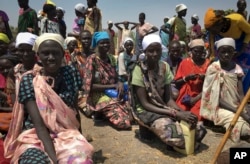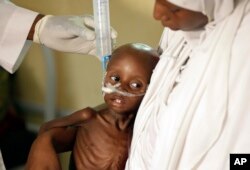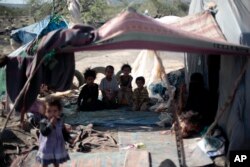A three- to four-month window remains to avert a famine that could potentially kill millions of people in three African countries and Yemen, the International Committee of the Red Cross warns.
The Swiss humanitarian agency said speed was of the essence to prevent a tragedy of massive proportions in Somalia, Yemen, South Sudan and northeast Nigeria.
Dominik Stillhart, ICRC Director of Operations, said agencies must urgently scale up their humanitarian operations and international donors must support these efforts to prevent millions of people in these countries from starving to death.
"This is not business as usual," he said. "Twenty million people facing starvation is not something that we are dealing with every day and, therefore, we really need to act now. If we act now, especially in Yemen and in Somalia, famine can be averted."
The International Committee of the Red Cross has launched a $400 million appeal to provide food, water, shelter and health care for five million of the most vulnerable people in the four famine-affected countries.
Stillhart said speed was of the essence. He said aid agencies and donors needed to learn the lessons of 2011 where the response to the famine in Somalia was "too slow, too little and 260,000 people died of starvation, more than half of them children under the age of five."
He added that ICRC staff was on the ground and delivering aid in all four countries, but because Somalia and Yemen were experiencing both drought and conflict, "we did not wait for donors to respond. We immediately started to respond as from February to this crisis that we saw evolving."
"I am for now not completely pessimistic with regard to the possibility to avert the worst, especially in these two countries."
Man-made disaster
He said the crisis in South Sudan and northeast Nigeria was different because famine in those countries was a man-made disaster caused purely by conflict.
While drought was playing havoc with the lives of people in Somalia and Yemen, he said famine in all four countries was "first and foremost the result of protracted conflicts."
"No amount of aid money will overcome political obstructionism, a failure to abide by the norms of warfare," he said.
Some 100,000 people in South Sudan's Unity State are facing famine, a crisis brought on by conflict and the inability of aid agencies to reach the area because of insecurity.
Bruce Orina, ICRC Deputy Regional Director for Africa, told VOA that more than three years of civil strife in South Sudan has led to multiple displacements of the population so "the population is unable to plant. And, we witnessed, in fact, in most of the areas where crops were planted, they were not tended to and, of course, they went to waste."
He described a similar scenario in northeast Nigeria where nearly two million people have become displaced by Boko Haram. Because of the conflict, people were unable to access land.
'Breaking point' in Yemen
ICRC officials are most concerned about the situation in Yemen because they noted that the gap between the needs of the population and the humanitarian response was bigger there than in the other countries.
"Words cannot capture the extent of the suffering of the Yemeni people," said Robert Mardini, ICRC Middle East director.
He said nearly 70 percent of the Yemeni people were dependent on humanitarian aid.
"Their resilience has reached a breaking point," he said.
Mardini said an average of 20 people were dying every day.
"Many, they die from treatable wounds, curable diseases because of the terrible state of the health infrastructure," he said. "Only 45 percent of health facilities are running today in Yemen, let alone the medicines, medical supplies, etc.
"The children are going hungry. There is an increase by 150 percent of child malnutrition and those are only indicators that are extremely alarming. This conflict is pushing Yemen closer to famine day after day."
'Worse-case scenario' looms
Stillhart told VOA that aid agencies needed to act now to get a massive humanitarian response underway to tackle the hunger crisis.
"I would say we have probably a window of three months during which large amounts of aid need to be distributed in order to avoid a worst-case scenario," he said. "It is really absolutely necessary that there is a strong mobilization of the donor community."
The international community is being bombarded with appeals for famine relief, including a $5.6 billion United Nations appeal, the ICRC's one-half billion-dollar appeal, and funding requests from numerous private aid organizations.
"There are significant needs," Stillhart said. "There are serious concerns in terms of having funding available sufficiently fast in order to avoid large-scale starvation."











